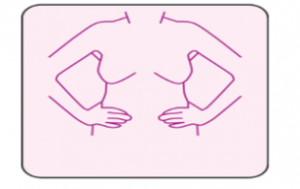There are three types of breast examination that are available to women to protect their health:
1. Breast self-examination
- Regular breast self-exams help you get familiar with what your breasts are like at different times so that when an unusual change develops in a breast, you will notice it early.
- Purpose: To get familiar with the appearance of the breasts and look out for any unusual changes
- How often? ONCE A MONTH.
You may also ask for a demonstration from your regular physician during your next consultation.
How to do a breast self-exam
1. Stand in front of a mirror. Place your hands at your waist and look for any changes in the size, shape, and colour of your breasts such as skin redness, rash, or inverted nipples.

2. Raise your arms and look for the above-mentioned changes to your breasts. Check whether there is any secretion from the nipples.

3. While looking at the mirror, search for any signs of fluid coming out of one or both nipples (watery, milky, or yellow fluid, or blood).

4. Feel breasts while lying down, using the right hand to feel the left breast and then the left hand to feel the right breast.
Use a firm, smooth touch with the first few finger pads of the hand. Keep the fingers flat and together.
Use a circular motion, about the size of a ten-peso coin.
Cover the entire breast from top to bottom, side to side — from the collarbone to the top of the abdomen, and from the armpit to the cleavage I tried

5. Feel breasts while standing or sitting.
Many women find that the easiest way to feel their breasts is when their skin is wet and slippery, so they like to do this step while taking a shower.
Cover your entire breast, using the same hand movements described in step 4.
Follow the steps for proper breast self-examination
This material and photos used are created and owned by Roche Bangladesh
Click on the link below to view a short video on breast self-exam in three easy steps.
Breast self-exam Video
This material is created and owned by Roche South Africa
If you notice anything unusual during your self-exams, you should contact a doctor as soon as possible to get a detailed exam. A number of different testing methods are available today to help doctors diagnose whether you have breast cancer.
2. Clinical breast examination
- Purpose: For healthcare personnel to perform checks to identify whether there are any lumps or abnormalities in the breasts
- Age 40 and above: every two years
- Ages 35 to 39: every two to three years
- Ages 20 to 34: every three years
3. Screening Mammography
- Purpose: To use an X-ray machine to capture images of breast tissue to detect microcalcification changes and early disease
- Women between 40 and 44 have the option to start screening with a mammogram every year.
- Women 45 to 54 should get mammograms every year.
- Women 55 and older can switch to a mammogram every other year, or they can choose to continue yearly mammograms.
References:
- American Cancer Society. American Cancer Society Recommendations for the Early Detection of Breast Cancer. https://www.cancer.org/cancer/breast-cancer/screening-tests-and-early-detection/american-cancer-society-recommendations-for-the-early-detection-of-breast-cancer.html. Accessed last July 2024.
- How to do a breast self-exam in three easy steps. https://www.roche.co.za/en/disease-education/Every_30_Days_Breast_Self_Exam.html. Accessed last July 2024.
- Breastcancer.org. Breast Self-Exam. https://www.breastcancer.org/symptoms/testing/types/self_exam, Last modified on October 24, 2019, April 2023.
- Image Credit: https://www.roche.com.bd/en/did-you-know/breast-self-examination.html, accessed last July 2024.
